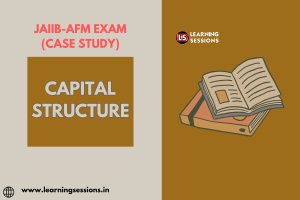The Junior Associate of Indian Institute of Bankers (JAIIB) certification plays a pivotal role in building basic knowledge for bankers in India. Among the principal subjects covered in the JAIIB syllabus is Accounting and Financial Management (AFM), where considering the “Capital Structure” is crucial. Learning Sessions will take you through this article and provide an in-depth look at capital structure, focusing on the important concepts, frameworks, and practical case studies that can enhance a banker’s understanding of this topic.

📚 JAIIB Study Resources 📚
👉 Check Here
👉 Check Here
👉 Check Here
👉 Get Tests Here
👉 Check Here
DOWNLOAD PDF CAPITAL STRUCTURE -CASE STUDY
Capital structure is significantly the mix of debt and equity that a company uses to finance its operations and growth. The right capital structure is crucial for optimizing a firm’s performance and ensuring sustainable growth. In the JAIIB AFM module, banking professionals are encouraged to analyze various capital structure strategies to understand the advantages and risks associated with different financing options.
For the extensive preparation of candidates, get details through our YouTube videos for JAIIB AFM Module wise Syllabus with explanations and tips to help candidates in their preparation journey.
You may also like these JAIIB case studies:
JAIIB | AFM | COMPONENTS OF BALANCE SHEET
JAIIB | AFM | GROSS PROFIT CALCULATION
Principal Concepts of Capital Structure:
- Equity Financing: Raising funds by issuing shares, which brings new shareholders and reduces control for existing owners but doesn’t require regular interest payments.
- Debt Financing: Raising funds through loans or bonds, which must be repaid with interest but allow existing shareholders to retain control.
- Hybrid Financing: Includes instruments like convertible debentures, preferred stock, etc., which combine features of both debt and equity.
Similarly, Banks often advise businesses on structuring their capital. Understanding the impact of debt and equity on financial stability and returns is key for bankers when assessing business clients and making lending decisions. The AFM module encourages JAIIB candidates to understand how different capital structures can affect a company’s financial health and long-term viability.
In the end, The JAIIB’s AFM module on Capital Structure offers valuable insights for banking professionals, covering both theoretical and practical aspects of capital structuring. Through case studies and scenario-based learning, applicants can gain a deep understanding of the dynamics that influence capital structure decisions. Learning Sessions provides additional information about JAIIB AFM PROFITABILITY RATIO by giving examples of real life scenarios.
Learn more about this case study through our YouTube channel and PDF.
Get access to our Telegram Channel for free Pdfs of JAIIB.





